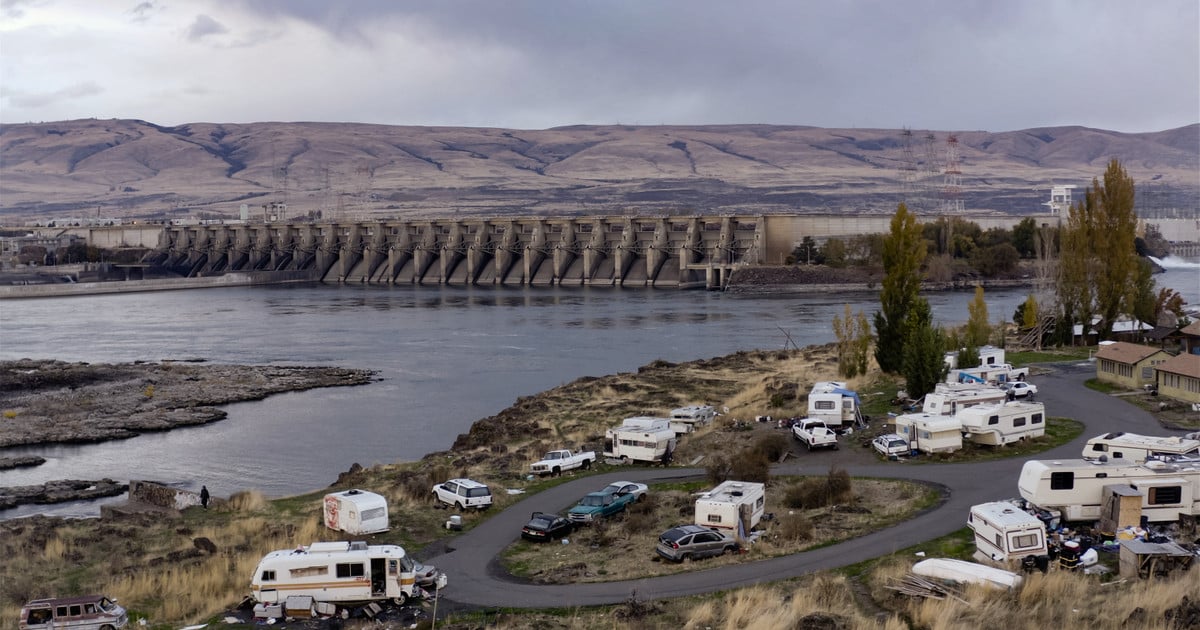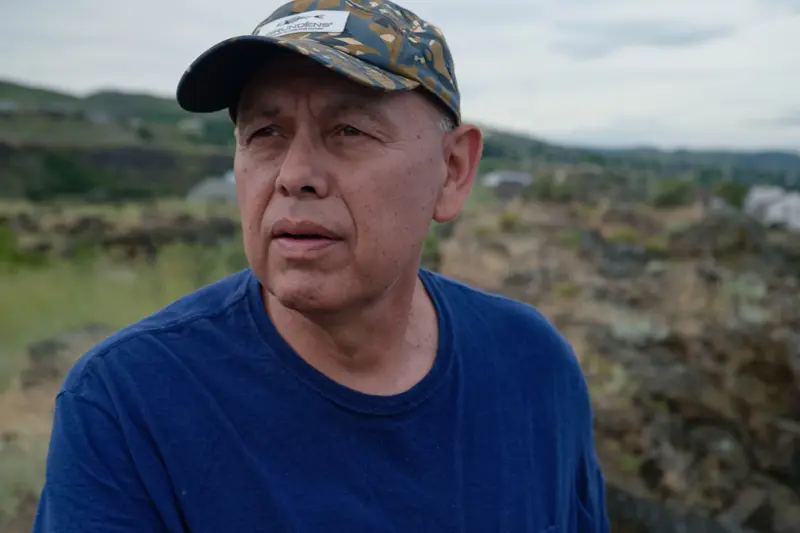This article was produced for ProPublica’s Local Reporting Network in partnership with Oregon Public Broadcasting. Sign up for Dispatches to get stories like this one as soon as they are published.

[ad_1]
The Biden administration released a report last week acknowledging “the historic, ongoing, and cumulative damage and injustices” that Columbia River dam construction caused Northwest tribal nations starting in the 20th century, including decimation of the salmon runs that Indigenous people were entitled to by government treaty.
Across 73 pages, the report from the U.S. Department of the Interior concludes “the government afforded little, if any, consideration to the devastation the dams would bring to Tribal communities, including to their cultures, sacred sites, economies, and homes.”
But here’s what’s not in the report: The injuries to Native people were not just an unforeseen byproduct of federal dam building. They were, in fact, taken into account at the time. And federal leaders considered that damage a good thing.
In government documents from the 1940s and 1950s, obtained by Oregon Public Broadcasting and ProPublica, government officials openly discussed what they called “the Indian problem” on the Columbia River, referring to the tribes’ fisheries that were protected under federal treaties. At times, they characterized the destruction of the last major tribal fishery as a benefit that dam construction would bring.
The archival government records were released to Columbia River treaty tribes several years ago under the Freedom of Information Act. They were first made public by OPB and ProPublica in March and April episodes of the podcast “Salmon Wars.”
The documents reveal that the government’s 1950s era of dam building on the Columbia was marked not by a failure to consider tribal impacts, but rather by a well-informed and intentional disregard for Native people.
“These documents shine a spotlight on a historic wrong” U.S. Sen. Jeff Merkley, an Oregon Democrat, said in a statement to OPB and ProPublica. “The government’s actions wiped out tribal communities, houses, villages, and traditional hunting and fishing sites with thousands of years of history.”
In response to emails detailing what the documents contained, Merkley said he would push the federal government to develop new tribal villages to replace the Indigenous fishing settlements that the dams flooded out.
U.S. Sen. Ron Wyden, a fellow Oregon Democrat, said he looked forward to working with tribes and the federal government to “to repair that shameful past.”
The Interior Department’s new report “writes yet one more painful chapter in the awful and deceitful history of federal decisions that willfully ignored Tribal communities’ rights and humanity,” Wyden said in an emailed statement.
What’s Left Out
The report does not mention any of the discussion from government officials previously reported by OPB and ProPublica.
A spokesperson for the Department of the Interior declined to comment when emailed the documents and asked whether the department was aware of them.
“We have nothing further to add beyond what’s in the extensive report,” press secretary Giovanni Rocco said in an email.
The report is a component of a recent 10-year agreement between the White House and tribes to restore endangered Columbia River Basin salmon populations.
Northwest tribes lauded the report as a long-overdue accounting of harms and a demonstration of the current administration’s commitment to listen to tribes and do right by them.
“The analysis highlights the many different ways the dams have impacted our cultures, lifestyles, diets, and economies and it got this information directly from the tribal people who have been affected,” Corinne Sams, chair of the Columbia River Intertribal Fish Commission, said in an emailed statement. “By listening to and including these testimonies, interviews, and statements, the federal government has taken tribes into consideration on this topic from a relationship of respect and willingness to learn.”
Salmon are estimated to have once totaled more than 10 million in the Columbia River, and they were central to the way of life for many tribes across the river basin. People fished along the river and its many tributaries in what are now Oregon, Washington, Idaho and parts of Canada for thousands of years. Salmon were a fixture of Indigenous people’s diet, religion and commercial trade.
Now, the river system’s salmon hover around 1 million. The decline is attributed largely to dams and other habitat loss stemming from development, along with overfishing.
Documents show government officials in the 20th century came to view the Native presence on the river as a detriment to the government’s own plans for hydropower – and harmful to the fish themselves.
In one memo from 1951, Sam Hutchinson, the acting regional director for the Bureau of Fisheries, summarized a conversation about the anticipated impact of The Dalles Dam, which ultimately drowned the tribes’ last major fishery, at Celilo Falls, when it was completed in 1957.
Hutchinson wrote, “I stated that the beneficial effects would compensate for the detrimental conditions that exist there at present.”
One of those benefits, according to Hutchinson: “The Indian commercial fishery would be eliminated and more fish would reach the spawning grounds in better condition.”
The successor agency to the Bureau of Fisheries, which is now a part of the National Oceanic and Atmospheric Administration, declined through a spokesperson to comment on Hutchinson’s historical remarks.
Hutchinson’s sentiment was also documented in meeting minutes from a 1947 committee of state, federal and local governments about future dam plans.
“We get up above and we run into the Indian problem at Celilo and other places. They are allowed to fish at will,” said Milo Moore, director of what was then called the Washington Department of Fisheries, according to the minutes. He said the tribes’ fishing made it difficult to maintain a constant supply of fish for the department’s own purposes. The state agency’s role included protecting and promoting the commercial and sport fisheries downriver, whose participants were predominantly white.
The head of the Port of Vancouver at the time, Frank Pender, also told federal officials of “the Indian problem” and said of tribal fishing, “certainly we don’t want it to stand in the way of the development of our own way of life.”
At one point during the proceedings, a man named Wilfred Steve was introduced as “our public relations officer for the Department of Fisheries and the Indians,” meeting minutes say. Steve acknowledged “these dams are going along and they are going to destroy their very life, the essence of life of these various tribes.”
Later in his remarks, the public relations officer praised the potential of education programs to assimilate Native people and stated “we hope that there will be no Indians.” He recommended paying the tribes in exchange for flooding their lands and destroying their fisheries.
Like the others quoted in the documents, Steve is now deceased.
Paltry Restitution
Randy Settler, a Yakama Nation fisherman whose family history of salmon fishing was previously documented by OPB and ProPublica, said the money his family received in exchange for the dam flooding Celilo and other tribal lands amounted to roughly $3,200 per individual.

Credit:
Katie Campbell/ProPublica
After dam construction, Congress and agency officials created programs to boost fishing opportunities that involved stocking the river with massive numbers of fish.
The archival government documents detail how these programs were used to justify allowing the dams to block the migration of native salmon. However, 99% of the stocked fish were almost entirely aimed at the fishing grounds below the dams that were used predominantly by white fishermen.
“It was kind of like what happened to the buffalo,” Settler told OPB and ProPublica during the initial reporting for “Salmon Wars.” “If they could rid the natural food of those tribes that they were dependent upon, they could weaken the tribes and get them to stop going across their ancestral territories. They would be more confined to their reservation lands where they could be controlled.”
The Biden administration has promised tribes it will restore wild salmon populations. As part of the 10-year agreement it signed with tribes, which includes a pause on any lawsuits over the dam system, the White House announced a plan to invest heavily in tribal-led salmon restoration and energy projects that could potentially replace the power from some hydroelectric dams. President Joe Biden also signed a memorandum calling for federal agencies to prioritize salmon recovery and to review the work to make sure they’re doing enough.
[ad_2]